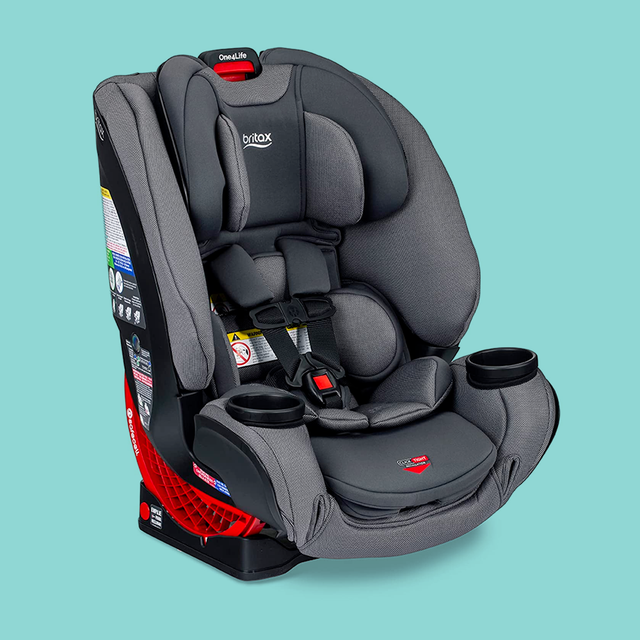The best seat for a baby in a car is a rear-facing infant car seat. This position provides the most safety for infants in case of a crash.
As a parent, ensuring your baby’s safety is always a top priority, especially when traveling by car. Choosing the right car seat can make a significant difference in protecting your little one in the event of an accident. The rear-facing infant car seat is designed to provide optimal protection for babies, absorbing impact forces and supporting their fragile neck and spine.
It is crucial to select a car seat that meets safety standards and is installed correctly to ensure your baby’s well-being while traveling in a vehicle. By prioritizing safety and following guidelines, you can have peace of mind knowing your baby is secure during car rides.

Which Seat is Best for Baby in Car?
Credit: www.goodhousekeeping.com
Importance Of Choosing The Right Seat
Choosing the right car seat for your baby is critical for their safety and well-being. With so many options available, it’s important to understand the significance of selecting the best seat to protect your little one during car journeys.
Safety First
Ensuring the safety of your baby in the car is paramount. A proper car seat can reduce the risk of injury in the event of an accident, providing crucial protection for your child. The right seat can make a significant difference in keeping your baby safe and secure while traveling in a vehicle.
Regulations And Guidelines
Adhering to regulations and guidelines for car seats is crucial in guaranteeing your baby’s safety. Understanding the requirements and recommendations laid out by regulatory bodies will help you make an informed decision when choosing a car seat for your child. Always ensuring that the seat meets the required standards will provide an added layer of protection for your little one.

Which Seat is Best for Baby in Car?
Best Car Seat And Stroller for Air Travel: Top Picks and Reviews
Credit: www.goodhousekeeping.com
Factors To Consider
When choosing a car seat for your baby, it’s crucial to consider various factors to ensure their safety and comfort. Understanding the key considerations can help you make an informed decision about which seat is best suited for your little one.
Age And Size Of The Baby
Age: Babies require car seats appropriate for their age and weight to ensure optimal protection in the event of a crash.
- Infants: Rear-facing seats for infants under one year old.
- Toddlers: Forward-facing seats for toddlers above one year old.
Size: The size of the car seat should be suitable for the baby’s height and weight to provide a secure fit and adequate support during travel.
Type Of Car Seat
Convertible Car Seats: Provide flexibility for use as the baby grows, allowing for extended use and value for money.
Booster Seats: Designed for older children to elevate them for proper seat belt positioning in the vehicle.
Installation Method
LATCH System: Offers a secure and straightforward installation method using lower anchors and tethers for children.
Seat Belt Installation: Another option for securing the car seat, suitable for vehicles without lower anchors.
Types Of Car Seats
Choosing the right car seat for your baby is crucial to ensure their safety while traveling. There are three main types of Car Seats to consider: Infant Car Seats, Convertible Car Seats, and Booster Seats.
Infant Car Seats
Designed for newborns and infants up to a certain weight, Infant Car Seats are rear-facing and offer excellent protection for the youngest passengers.
Convertible Car Seats
Convertible Car Seats can be used in both rear-facing and forward-facing positions, catering to the needs of growing children. They provide extended use and flexibility.
Booster Seats
Booster Seats elevate the child to the correct height to use the vehicle’s seat belt effectively. They are suitable for older children who have outgrown traditional car seats.
Pros And Cons Of Different Seats
When it comes to ensuring the safety of your little one on the road, choosing the right car seat is crucial. Each type of car seat has its own advantages and disadvantages, so it’s important to weigh them carefully to make an informed decision. Let’s explore the pros and cons of different seats to help you determine which option is best for your child’s needs.
Infant Car Seat
Pros:
- Specifically designed for infants, providing excellent support for their small bodies.
- Portable and can be easily attached to a compatible stroller, making it convenient for parents on-the-go.
Cons:
- Infant car seats have a lower weight and height limit, requiring a transition to a different seat as your baby grows.
- May not be the most cost-effective option, as you will need to purchase a new seat once your child outgrows it.
Convertible Car Seat
Pros:
- Designed to accommodate both infants and toddlers, eliminating the need for a separate infant car seat.
- Can be used in a rear-facing position for infants and then converted to forward-facing as your child grows.
Cons:
- May not be as portable or convenient as an infant car seat, as it is typically not compatible with strollers.
- It’s important to check the weight and height limits to ensure it will accommodate your child as they grow.
Booster Seat
Pros:
- Designed for older children who have outgrown their convertible car seat but are not yet ready for a regular seatbelt.
- Provides the necessary elevation for the child to position the seatbelt correctly across their body.
Cons:
- Booster seats do not offer the same level of protection as infant or convertible car seats, as they solely serve to position the seatbelt correctly.
- They are not suitable for children under a certain weight or height, so it’s essential to ensure that your child meets the requirements.
Tips For Installing And Using Car Seats
If you have a baby, one of the most essential items you’ll need for their safety in the car is a car seat. However, simply having a car seat is not enough – it’s crucial to install and use it correctly to ensure optimal protection for your little one. In this section, we will provide you with valuable tips on properly installing and using car seats. Remember, the safety and well-being of your baby depend on it!
Proper Installation
When it comes to installing a car seat, it’s essential to follow the manufacturer’s instructions carefully. Here are some key points to keep in mind:
- Place the car seat in the back seat of the vehicle.
- Secure the car seat using either the seat belt or the LATCH system, depending on the manufacturer’s guidelines.
- Ensure that the car seat is securely attached, with minimal room for excessive movement.
- If using the seat belt, make sure it is threaded correctly through the designated slots and pulled tight.
Harness And Straps
The harness and straps of a car seat are crucial for keeping your baby securely in place. Follow these tips to ensure proper usage:
- Ensure that the harness is snug but not overly tight. You should be able to fit only two fingers between your baby’s collarbone and the harness strap.
- Make sure the chest clip is positioned at armpit level to keep the harness straps properly in place.
- Regularly check that the straps are not twisted and are appropriately adjusted for your baby’s size.
- As your baby grows, remember to adjust the harness and straps accordingly.
Position In The Car
Choosing the right position for your baby’s car seat can significantly impact their safety. Take note of these recommendations:
- Whenever possible, place your baby’s car seat in the middle of the back seat. This position offers the most protection from side-impact collisions.
- If using multiple car seats, make sure to check the manufacturer’s guidelines for proper placement.
- Avoid installing the car seat in a seating position with an active airbag or near another passenger.
- Regularly check that the seat is securely installed, especially after adjustments or if someone else used the car seat.
Remember, installing and using a car seat correctly is vital for your baby’s safety on the road. Following these tips ensures that you provide the best protection for your little one during every car journey.

Which Seat is Best for Baby in Car?
Best Car Seat And Stroller for Air Travel: Top Picks and Reviews
Credit: www.nytimes.com
Common Mistakes To Avoid
When it comes to ensuring the safety of your baby in the car, selecting the right seat is crucial. However, there are common mistakes that many parents make when using baby car seats. Avoiding these mistakes is imperative to protect your little one during car rides. Let’s not waste any more time and dive into understanding what these mistakes are and how you can prevent them.
Using Expired Car Seats
One of the most common mistakes parents make is using expired car seats. Just like other products, car seats have an expiration date, usually indicated on a label or stamped into the seat itself. It is important to note that car seats degrade over time due to various factors such as wear and tear, exposure to extreme temperatures, and changes in safety standards. Using an expired car seat puts your baby at risk as it may not provide adequate protection during an accident.
Incorrect Harness Positioning
Another mistake to avoid is incorrect harness positioning. The harness is the part of the car seat that holds your baby in place and secures them during a collision. Many parents tend to position the harness either too loose or too tight. When the harness is too loose, it fails to restrain your baby properly, posing a danger during sudden stops or accidents. On the other hand, a harness that is too tight can cause discomfort and restrict your baby’s breathing. It’s important to ensure that the harness is snug but not too tight, with the straps at or below your baby’s shoulders for optimal protection.
Improper Seat Angle
Ensuring the correct seat angle is another crucial aspect of safely using a car seat for your baby. Incorrect seat angle may lead to your baby’s head falling forward, compromising their breathing or increasing the risk of injury in the event of a crash. To avoid this mistake, it’s necessary to follow the manufacturer’s instructions and adjust the seat to the recommended angle based on your baby’s age and weight. Additionally, using angled foam inserts or towels is a common mistake that should be avoided, as it can affect the integrity of the car seat’s protection.
By being aware of these common mistakes and taking necessary precautions, you can ensure your baby’s safety and well-being during car rides. Remember, using an expired car seat, improper harness positioning, and incorrect seat angle are avoidable errors that every parent should steer clear of. Protect your precious bundle of joy by selecting the right seat and using it correctly every time you hit the road!
Conclusion
Ensuring your baby’s safety in the car is crucial. Choosing the right seat that meets safety standards and fits your child’s age and size is key. Remember to install the seat correctly and follow the manufacturer’s guidelines. Prioritize research and quality when making your selection for peace of mind and security on the road.




